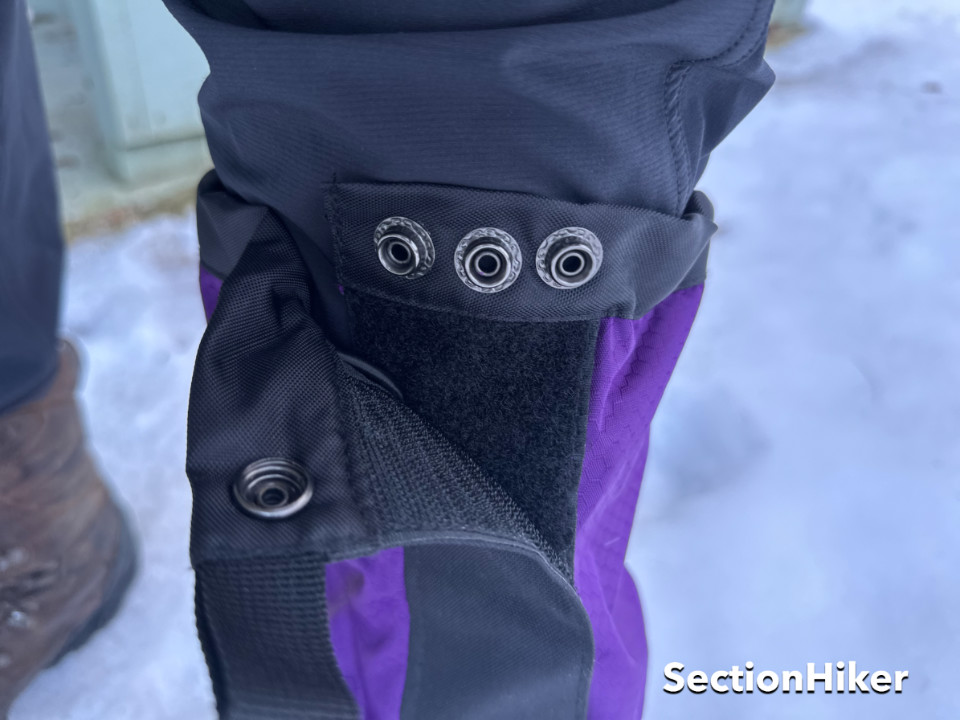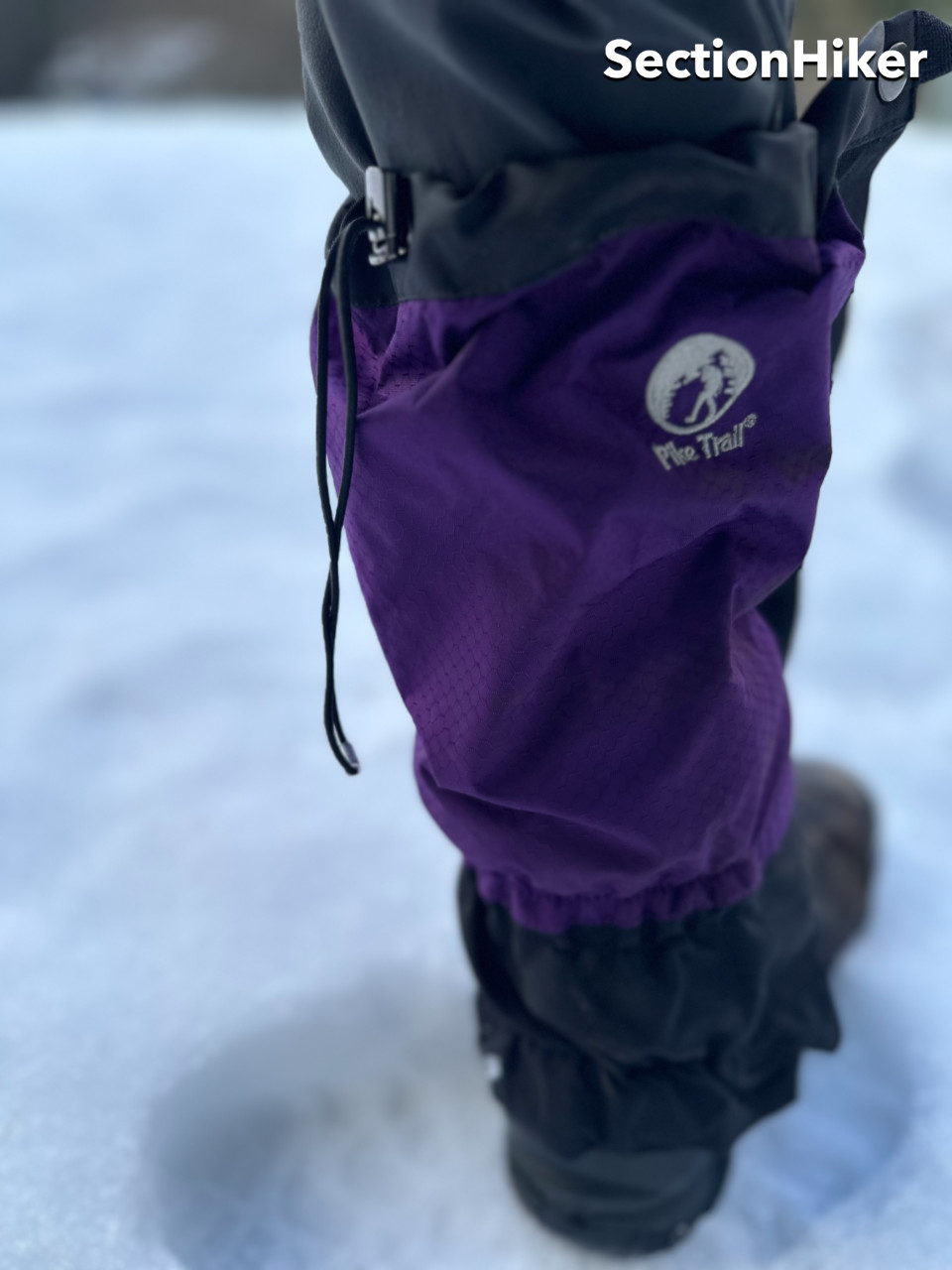
Pike Trail High Gaiters are polyester gaiters with a unique fitting system and design that overcomes the sizing limitations of most high gaiters, including and especially Outdoor Research Crocodiles, which are the most popular high gaiters sold today. In addition to a gaiter hook and front velcro closure, they have a two sets of three snaps at the top and bottom and a calf drawcord that prevents them from falling down around your ankles. Sold on Amazon, they’re one of the few hiking products available there that are truly innovative and not knock-off copies of pre-existing products. And their customer service is really great!
Specs at a Glance
- Gender: Unisex
- Material: Polyester
- Sizing: One size
- Height: 15″
- Waterproof/Breathable Fabric: No
- Closure: Snaps, Velcro
- Instep Strap: TPU
- Gaiter Hook: Yes
- Calf Drawstring: Yes
High gaiters can be worn year round for hiking, backpacking, bushwhacking, fishing. hunting, and other outdoor activities. I mainly use them in for winter hiking where they have three primary functions:
- Adding warmth to your lower legs
- Preventing snow from wetting your socks and freezing
- Protecting against self-inflicted crampon strikes
Traditional Gaiter Sizing
The problem with most traditional high gaiters is that they fall down around your ankles, which gets pretty annoying. Most high gaiters, including OR Crocodiles, are sized based on boot size, not the size of your lower legs. This works tolerably well if you use huge, chunky mountaineering boots for winter hiking and full step-in or universal crampons for traction. But these days, most winter hikers have switched to using single-layer 400g or 200g insulated winter boots with microspikes and trail crampons for added traction.

If you hike in chunky mountaineering boots, I’d stick with OR Crocodiles or gaiters like them because your boots are wide enough to “hold them up.” They’re also designed to completely cover the front laces so that sharp crampon teeth don’t slice through them or get caught in between them and cause a fall. But if you’re using a much “skinnier” 400g or 200g insulated winter boot, these Pike Trail Gaiters will work a lot better, as I explain below.
Pike Trail Gaiter Sizing
Unlike a lot of high gaiters, the Pike Trail Gaiters are only available in one size – which makes them a lot easier to purchase because you can’t make a sizing mistake. The gaiters close in rhe front using snaps and velcro: the top and bottom ends have three snaps that let you size the circumference of the gaiter to match your legs, even if the top is larger than the bottom. The velcro’s primary function is to seal the front of the gaiter to prevent snow from entering, but it also provide a means to get a custom fit although it’s be difficult to achieve that with the velcro alone.
The front of these gaiters does not cover your laces all the way to the toe box which is why I’d only recommend wearing them with a lightweight traction aid like microspikes or trail crampons where the risk of slicing through your laces or tripping on them is very low (unlike the long spikes of a full mountaineering crampon). By exposing more of your laces, you get a much better fit around the lower legs than if the laces were completely covered as they are in more traditional mountaineering gaiters.

There is still a hook at the bottom of the gaiters to prevent them from riding up your leg, but you should attach it to your laces and not the front gaiter ring that comes with many insulated winter boots because it can’t reach to the front of your boots.
The gaiter is also held “down” by a TPU strap the runs under the sole and up the side, passing through stainless steel buckles (not plastic) for better durability. It important to position the buckle on the outside of your boots, not the inside where it might get ripped off by your other boot if you misstep or your traction aid gets caught in it. A lot of people make this mistake, even with a traditional gaiter.

Calf Drawstring
The Pike Trail gaiters come with an adjustable drawstring with a cord lock that is positioned above your calf. Most peoples’ calves are thicker than their lower legs so tightening this cord above the top of the calf keeps the gaiters from falling down and it doesn’t slip over time. It’s best if you tuck the extra slack in the cord into your gaiter to prevent it from getting caught on anything while hiking.
Breathability
A lot of more traditional mountaineering gaiters are made with Gore-tex or some other waterproof/breathable fabric, although I’ve used lots of them and never found one that is all that breathable. The Pike Trail Gaiters are not made with waterproof fabric, but plain old polyester with thin fabric on top (purple) and heavier more durable fabric (black) at the base where the most abrasion occurs. The upper’s polyester is actually quite breathable and I haven’t experienced any sweating from these gaiters and I’ve hiked quite a lot in them.

Recommendation
The Pike Trail High Gaiter is compatible with any pair of hiking boots, although I primarily use them for winter hiking with 400g and 200g insulated winter boots. They’re only available in one universal size and have a closure system that makes them compatible with a wide range of lower leg circumferences. I used them most of last winter and continue to this winter with Oboz Bridger 10″ 400g boots and The North Face Vectiv 200g mids. They’re quite inexpensive compared to traditional mountaineering gaiters designed for use with mountaineering boots and much better performing in terms of fit, breathability, and durability.
SectionHiker is reader-supported. We only make money if you purchase a product through our affiliate links. Help us continue to test and write unsponsored and independent gear reviews, beginner FAQs, and free hiking guides.
Disclosure: The author owns this product.

